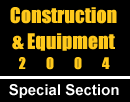
Surveys
Awards
DJC.COM
March 25, 2004
Beware of vulnerabilities during construction
Washington State University

Carper
|
Small projects are not immune from catastrophic construction accidents. Half of all deaths reported from falling are from heights less than 30 feet. Eighty percent of trench cave-in fatalities occur in trenches less than 15 feet deep.
Injuries and fatalities occur all too frequently on construction sites despite education, legislation and application of advanced risk management techniques. Most accidents are preventable. Common underlying causes are ignorance, carelessness, negligence, and greed — the four “horsemen of the apocalypse.”
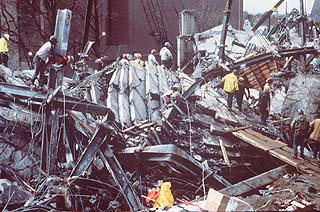
Photo courtesy of the National Institute of Standards and Technology
The 1987 collapse of L’Ambiance Plaza in Bridgeport, Conn., killed 28 workers. Deficient temporary connections and instabilities contributed to the sudden collapse.
|
Particularly disheartening are the many repetitive accidents caused by unreasonable construction schedules, where unnecessary risks are taken in the interest of profit.
Unfortunately, temporary work, such as excavation, seldom receives the attention given to more permanent construction. Despite advances in soil mechanics and the existence of well-known procedures for safe temporary support, excavations frequently lack the bracing mandated by government regulations.
The attitude among workers is: “If we work fast enough, nothing serious will happen.” Experience may reinforce this attitude, because workers usually do complete the work without mishap. However, experience is not necessarily a good teacher, particularly when the lesson gives one a false sense of security.
Collapse of the structure itself, while it is being erected, is a major source of injury and death. Buildings and bridges are particularly vulnerable to structural failure during construction. Builders should be aware of these temporary vulnerabilities. The most common causes of structural collapse during construction are: excessive construction loading; improper sequencing; temporary material or system weaknesses; and temporary instabilities.
Excessive construction loading
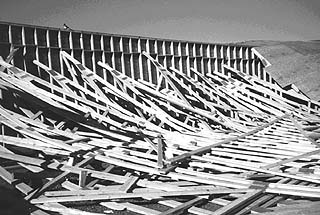
Photo courtesy of Ken Carper
Unbraced roof trusses were blown down in 1999 at this project in Moscow, Idaho.
|
Loads applied to structural members during construction quite often exceed the design service loads that will act on the completed building. Architects and structural engineers cannot anticipate all loads that might be applied to a building during construction.
Negligent stockpiling of heavy materials, for example, is a common source of catastrophic structural failures. Frequently, roofs fail due to the careless stockpiling of roofing materials, such as gravel for flat built-up roof construction.
Such failures can be sudden collapses, resulting in injuries to the construction workers.
In December 1985, a catastrophic accident occurred in Los Angeles during construction of a 21-story steel-frame building. Eighty tons of structural steel sections were stockpiled on one bay on the fifth floor, loading the bay to twice its designed capacity. Three beams failed suddenly at their temporary connections, precipitating a progressive collapse of 10 bays all the way to the ground floor. Three construction workers were killed in the accident.
Improper sequencing
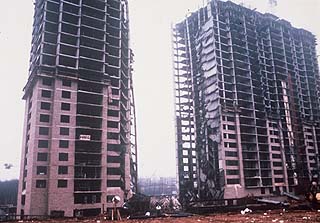
Photo courtesy of the National Institute of Standards and Technology
Premature removal of shoring caused the 1973 collapse of Bailey’s Crossroads, a housing project in Fairfax County, Va. Fourteen workers were killed.
|
The sequence of operations is fundamentally critical to structural safety in many projects. Prestressed concrete structures require particular care in following the proper procedures, whether pre-tensioning work at the precast plant or post-tensioning work at the construction site.
The design engineer makes certain assumptions about sequencing, and if these are not communicated clearly to those responsible for field operations, the results can be catastrophic.
Construction sequencing is also important for preserving the stability of incomplete structures. When the building is an assembly of prefabricated structural elements, the erection procedure is an integral part of the engineering design concept. Unless the procedures are clearly specified and diligently followed, there is no guarantee that the structure will be stable during all stages of its assembly.
Errors in sequencing contributed to the totality of the tragic 1987 collapse of the L'Ambiance Plaza housing project in Bridgeport, Conn. Twenty-eight construction workers were killed when failure occurred in the slab-lifting assembly. At the time of collapse, the building relied on shear walls for stability, but construction of the shear walls was lagging behind the lifting operation.
Temporary material or system weaknesses
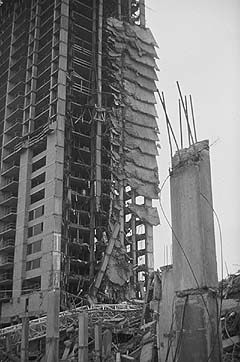
Photo courtesy of the National Institute of Standards and Technology
At Bailey’s Crossroads, concrete was placed on the 24th floor while shoring was prematurely removed from the 22nd, causing a progressive collapse down to the ground level.
|
During construction, some materials, particularly cast-in-place concrete, have not yet achieved their design strength. Assemblies of timber, steel and precast concrete rely on temporary field connections that may not be as strong or secure as the final, designed connections. These factors are responsible for many construction accidents.
Inadequate, temporary field connections can lead to catastrophic failures when construction loads are applied to the partially erected frame.
The history of concrete construction has been plagued by construction failures, often accompanied by multiple injuries and fatalities. Most failures of cast-in-place concrete projects occur during construction, before the concrete has sufficient strength to support its own weight. Premature removal of shoring or formwork and collapse of the structure providing temporary support are the most common explanations. Rushing the construction schedule is almost always the underlying cause.
The most disastrous construction accident in the history of the United States was caused by premature loading of uncured concrete. On April 27, 1978, a reinforced-concrete cooling tower at a power plant in Willow Island, W.Va., collapsed during construction. Fifty-one construction workers were killed. The top 5 feet of the outer shell around the entire circumference of the cooling tower fell inward, along with a four-level erection system, work platforms and safety nets. All 51 construction workers fell 168 feet, entangled in the concrete, the erection system and the construction equipment. Construction loads were applied to the shell before the concrete of the uppermost lift — placed the preceding day — had gained adequate strength.
In March 1973, a dramatic multistory building collapse involving premature removal of shoring occurred at Bailey's Crossroads in Fairfax County, Va. The construction pace for the 26-story project was quite rapid; one floor slab completed per week. At the time of the collapse, concrete was being placed on the 24th floor, and shoring was simultaneously being removed from concrete at the 22nd floor. The sudden, progressive collapse carried the weight of the failed concrete of the 22nd, 23rd and 24th floors all the way to the ground level. The failure killed 14 construction workers and injured 35.
Several investigations came to the same conclusion for the Bailey's accident. The concrete had simply not attained sufficient strength to carry the construction loads that were placed on it. The shear strength of the slabs would have been acceptable if the concrete had reached its specified capacity before the shoring was removed.
Temporary instabilities
| Infamous construction failures |
• Bailey’s Crossroads, Fairfax County, Va., March 1973. Progressive collapse of a 26-story reinforced concrete residential tower killed 14 construction workers and injured 35. • Cooling tower scaffold collapse, Willow Island, W.Va., April 1978. Premature loading of cast-in-place concrete resulted in the deaths of 51 construction workers, the most lethal construction accident since the 1907 collapse of the Quebec Bridge over the St. Lawrence River took 74 lives. • Rosemont (Illinois) Horizon Arena, August 1979. Glued-laminated timber roof arches spanning 288 feet collapsed, killing five workers and injuring 16. • Harbour Cay Condominium, Cocoa Beach, Fla., March 1981. A five-story, cast-in-place reinforced concrete building collapsed due to design and construction deficiencies, killing 11 construction workers and injuring 23. • East Chicago, Ind., highway ramp accident, April 1982. Thirteen construction workers were killed and 17 injured when the temporary falsework collapsed during construction. • L’Ambiance Plaza, Bridgeport, Conn., April 1987. A 16-story post-tensioned prestressed concrete lift-slab apartment project collapsed suddenly during construction, resulting in 28 deaths. Frequently, the construction industry leads all other industries in annual reported fatalities. It is not uncommon for more than 2,000 construction workers to be killed on the job in a given year, or about 10 fatalities per workday on construction sites in the United States. Most are the result of preventable accidents. Information from “Why Buildings Fail” by Ken Carper |
The architect and engineer envision a building in its completed condition with all of its components functioning together to resist both vertical and lateral loads.
There are countless examples of construction stability failures, under both gravity and horizontal loads, in buildings that would have been safe if the final connections, shear walls, and floor and roof diaphragms had been completed. Such failures can be dramatic, bringing down large sections of the unfinished building or even the entire assembly. And they are particularly dangerous because they tend to be sudden, giving little or no warning.
Stability of an incomplete framework, whether of timber, steel or precast concrete, relies on temporary bracing. Determining the stability requirements for an incomplete assembly with an irregular, complicated, evolving geometry is a challenging assignment for the most skillful engineer or construction superintendent.
Roof structures often fail before they can be braced or sheathed. Long, tall, slender trusses and arches require temporary bracing to hold them in position. Light-frame timber buildings often use pre-engineered, manufactured metal-plate-connected roof trusses. The truss manufacturers provide handling, erection and bracing instructions, but some installers ignore these recommendations.
Frequent failures underscore the critical need for temporary bracing. The typical explanation given in the media is “a freak wind gust.” A more accurate reason is human error: ignorance and carelessness.
Of course, stability failures due to insufficient temporary support are not limited to small buildings. Some very large projects, designed with a high degree of sophistication, have experienced sudden and total collapse during erection.
In 1987, the north addition to the University of Washington football stadium was the site of a dramatic and catastrophic construction failure. At the time of the collapse, there was very little of the designed structure in place to provide lateral stability. The completed design would eventually provide resistance to lateral loads by braced frame action in one direction, and by crossbracing and diaphragm action of the seat plates and metal roof deck in the other direction. None of these were in place at the time of the collapse.
Inadequate temporary support was undoubtedly the cause of failure of the stadium addition. Fortunately, there was some warning that this collapse was imminent. If it had not been for the actions of an alert construction superintendent in clearing the construction site, there would have most certainly been serious injuries and fatalities.
Despite the many hazards and risks inherent to the construction process, a vast majority of projects are completed without accident or injury. There are no more rewarding careers than those found in the construction industry. Builders add value to society. They create the infrastructure responsible for public health and quality of life. Awareness of the hazards and diligent management of the risks can enhance the safety and the profitability of these achievements.
Ken Carper is professor of architecture and construction management at Washington State University. He is editor of the Journal of Performance of Constructed Facilities, published by the American Society of Civil Engineers, and author of three books: “Construction Failure,” “Forensic Engineering” and “Why Buildings Fail.”
Other Stories:
- Spiking costs shadow construction market
- Construction industry struggles to accept ISD
- The roots of Washington's new building code
- Government takes a shine to alternative bids
- New laws have yet to stem tide of condo suits
- Sleep and safety make sound partners
- WSU students train for the Solar Decathlon
- An ACE in the hole for high schoolers
- Do you know who your successor is?
- Six ways to keep your customers happy
- How ergonomics can fatten the bottom line
- More training needed for crane operators
- Shattering the myth of wired glass
- Want big profits? Make yours a high-trust company
- Equipment costs don't have to break the bank
- Listen up workers: act quickly on hearing loss
- In a lawsuit? Who's paying the lawyers?
Copyright ©2009 Seattle Daily Journal and DJC.COM.
Comments? Questions? Contact us.